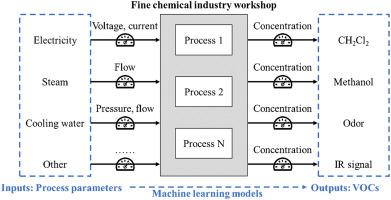Journal of Cleaner Production ( IF 9.7 ) Pub Date : 2022-08-06 , DOI: 10.1016/j.jclepro.2022.133406 Hanyun Ye , Zhen Du , Hao Lu , Jinping Tian , Lyujun Chen , Wenhao Lin

|
The control of volatile organic compounds (VOCs) is one of the key challenges in the chemical industry. This study aims to establish a high temporal-resolution prediction model of VOCs concentrations in pharmaceutical synthesis process using machine learning methods. We explored three machine learning methods, support vector machine, random forest, and extreme gradient boosting (XGBoost), with hourly process monitoring data in real production process as inputs. Key findings are as follows: (1) the average R2 of different VOCs concentration prediction models ranges from 0.40 to 0.93, (2) in most cases, the performance of RF and SVM is better than XGBoost, while the performance of RF and SVM is much close, (3) models lacking historical VOCs concentration features as inputs usually perform worse with poor R2 (ranges from 0.33 to 0.80), meanwhile the performance of models is similar when using different feature combinations with historical VOCs concentration, and (4) feature importance shows that the VOCs concentration at 1 h earlier has a great influence on the predicted VOCs concentration at time t. To further optimize the performance of the model driven by time series data, additional process monitoring data in the distributed control system should be added. This study is meaningful for early warning and accurate control of VOCs emission in chemical processes.
中文翻译:

使用机器学习方法通过每小时过程参数预测化工生产中的 VOC 排放
挥发性有机化合物(VOC) 的控制是化工行业的主要挑战之一。本研究旨在利用机器学习方法建立药物合成过程中VOCs浓度的高时间分辨率预测模型。我们探索了三种机器学习方法,支持向量机、随机森林和极端梯度提升(XGBoost),以实际生产过程中每小时的过程监控数据作为输入。主要发现如下: (1) 平均 R 2不同VOCs浓度预测模型的范围从0.40到0.93,(2)在大多数情况下,RF和SVM的性能优于XGBoost,而RF和SVM的性能非常接近,(3)模型缺乏历史VOCs浓度特征因为输入通常在 R 2较差的情况下表现更差(范围从 0.33 到 0.80),同时在使用不同特征组合和历史 VOCs 浓度时模型的性能是相似的,并且(4)特征重要性表明 1 h 前的 VOCs 浓度对预测的 VOCs 浓度有很大影响时间t。为了进一步优化由时间序列数据驱动的模型的性能,应该在分布式控制系统中添加额外的过程监控数据。本研究对化工过程中VOCs排放的预警和精准控制具有重要意义。











































 京公网安备 11010802027423号
京公网安备 11010802027423号